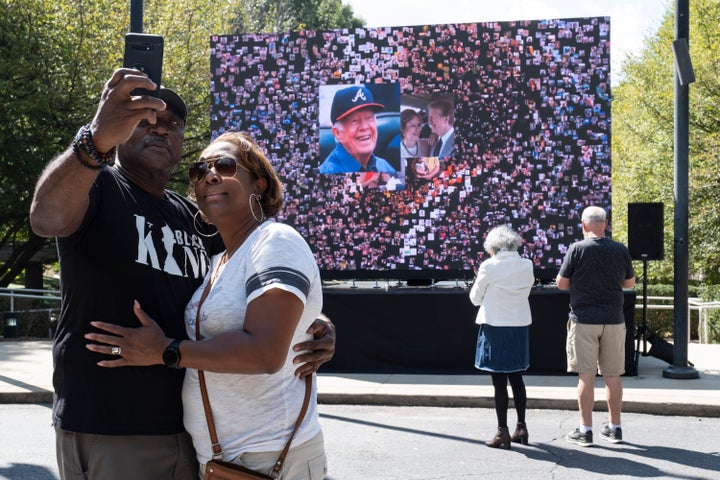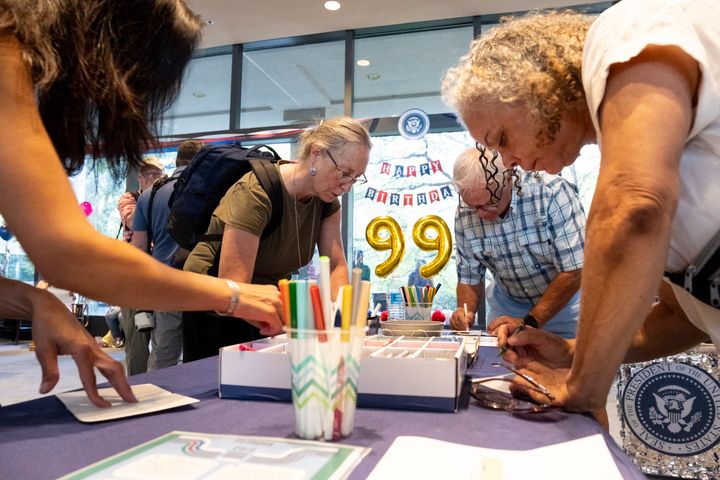ATLANTA (AP) — J. Edgar Hoover became the federal government’s top cop. Ellis Island was curtailed as a portal for immigrants to the United States. France hosted the first Winter Olympics. And a baby in rural Georgia became the first future American president born in a hospital.
The year was 1924, and that tiny fellow in Plains was James Earl Carter Jr., known as “Jimmy” from the start.
The 39th president was celebrated Saturday at his presidential library and museum ahead of his 99th birthday on Sunday. The party was moved up a day to ensure it wouldn’t be canceled by a potential federal government shutdown that Congress narrowly averted Saturday evening with a deal sent to President Joe Biden for his signature.
“I think of him as a man who did so much to help low-income people and minorities―and I was both growing up,” said Marcia Rose, who brought her grandchildren from suburban Marietta to the Carter Presidential Center near downtown Atlanta.
A native of Buffalo, New York, Rose said she is not old enough to have voted for Carter, a Democrat, when he won in 1976 or when he lost to Republican Ronald Reagan four years later. “But I’m old enough to remember his impact,” she said. “I wanted to be here to honor him and for us to be part of that history.”
Rose joined a few thousand well-wishers who wrote birthday cards that will be taken to Carter’s home in Plains. He has been in hospice care since February, spending time his wife, Rosalynn, who is 96 and suffering from dementia, and other family members. Carter is the longest-lived U.S. president ever. Rosalynn Carter trails only Bess Truman, who died at 97, as the longest-lived first lady.
Attendees on Saturday saw video tributes to Jimmy Carter from celebrities and competed in rounds of trivia that highlighted underappreciated details about his life and how much the world has changed since it began. A discounted 99-cent ticket allowed them museum access, which includes a replica of the Oval Office as it appeared during Carter’s 1977-81 White House term. And those who stood in line early enough got birthday cake decorated in green, the color Carter chose for his presidential campaign materials in 1975 to reflect his environmental priorities.
For many attendees, the occasion was another step in the evolution of how Carter is remembered.
“Growing up in Texas, our history classes talked about him mostly as a failure, a weak figure, especially militarily and on foreign affairs,” said Zach K, an Atlanta banker born after Carter’s presidency.
Marlene Salgado is now a public high school history teacher. But as a student herself, “all I remember learning about him was the ‘malaise speech’ on the energy crisis and the hostages in Iran.”
Now, the pair is reading together a comprehensive Carter biography, “His Very Best” by Jonathan Alter, which is among several recent books and documentaries that reassess Carter as more than a failed president who rehabilitated himself as a global humanitarian through his work at The Carter Center.

Salgado noted that it was Carter who secured the release of American hostages held in Tehran from late 1979 through Inauguration Day 1981.
“Reagan gets the credit from most people,” she said. Indeed, Carter worked for the hostages’ freedom even after Reagan’s Election Day landslide. Carter and his administration secured a deal in the final days of his presidency, but Tehran staged the actual release hours after Reagan was sworn in. Reagan sent Carter to greet the hostages in Europe.
“The details get lost,” Zach K said. “I think his focus on diplomacy and peace should be admired. We need more of that now.”
Salgado said she teaches from Carter’s negotiations with Israel’s Anwar Sadat and Egypt’s Menachem Begin on the Camp David Accords. She called it “an important peace” of understanding the modern political landscape of the Middle East.
Ken Driggs, who voted for Carter, said the former president has been vindicated on many matters that helped lead to his defeat.
“The Panama Canal decision was so unpopular,” he said, referring to Carter’s treaty that ultimately turned over control of the waterway in Central America. “But it was the right thing to do at the time” for stability in a volatile region, “and that’s the accepted reality now.”
Driggs first met Carter as a candidate for president in 1976 because of his job at the time as an aide to the speaker of the Florida House of Representatives.
“I remember him being very informed, very detailed on policy matters,” Driggs said.
Florida was a consequential state for Carter. In the 1976 primary there, he defeated Alabama Gov. George Wallace, a former segregationist and perhaps Carter’s most significant remaining threat for the Democratic nomination. In the general election, Florida was part of Carter’s sweep of the South from North Carolina to Texas, a swath of electoral votes that was the difference in his contest against Republican incumbent Gerald Ford.
Driggs said Carter’s political acumen is sometimes overlooked because once he was president, he approached decisions on the merits, often to his peril. Driggs acknowledged that inflation and interest rate spikes were an albatross for Carter, just as they have been for Biden ahead of his 2024 reelection campaign. But Driggs noted that Carter stayed out of the way as his appointee as Federal Reserve chairman, Paul Voelker, raised rates to combat rising prices.
“History,” Driggs said, “is already starting to be kinder to President Carter than voters were.”

Festivities at the Carter Library & Museum, including 99-cent admission, were expected to continue Sunday after the spending deal to keep the government open. Regardless of any shutdown, events will include a naturalization ceremony at The Carter Center, which is not a federal facility, recognizing 99 new U.S. citizens. The Carter family planned to celebrate privately in Plains.


